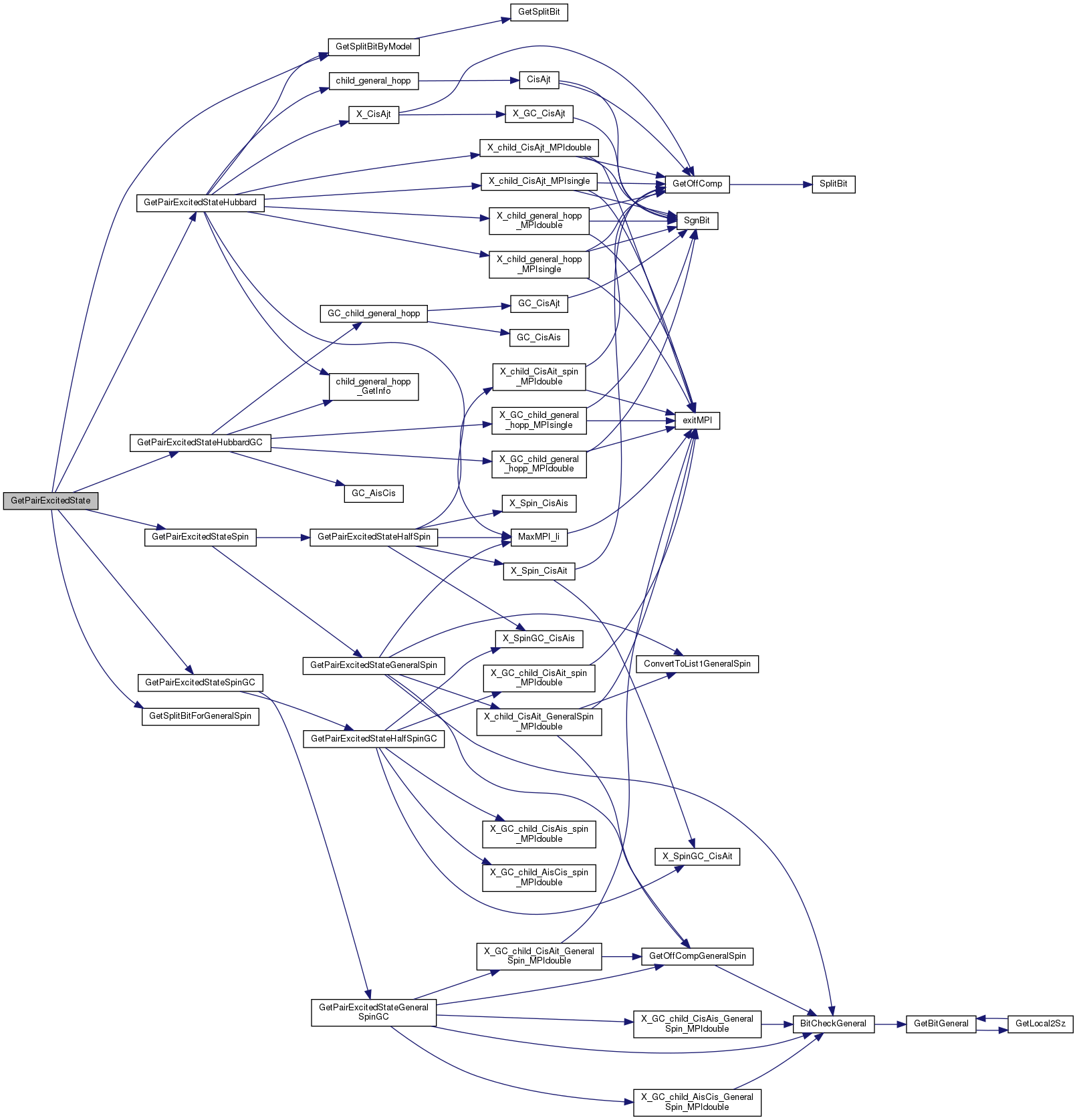Calculating the pair excited state generated by the pair operator
\[ \sum_{i,j, \sigma_1, \sigma_2} h_{i,\sigma_1, j, \sigma_2} c_{i\sigma_1} c_{j\sigma_2} (a_{i\sigma_1} a_{j\sigma_2})\]
, where \( c_{i\sigma_1} (a_{i\sigma_1})\) indicates a creation (anti-creation) operator at \(i\)-th site with \( \sigma_1 \) spin. More...
#include "bitcalc.h"#include "mltplyCommon.h"#include "PairEx.h"#include "PairExHubbard.h"#include "PairExSpin.h" Include dependency graph for PairEx.c:
Include dependency graph for PairEx.c:Go to the source code of this file.
Functions | |
| int | GetPairExcitedState (struct BindStruct *X, double complex *tmp_v0, double complex *tmp_v1) |
| Calculating the pair excited state by the pair operator; \[ \sum_{i,j, \sigma_1, \sigma_2} h_{i,\sigma_1, j, \sigma_2} c_{i\sigma_1} c_{j\sigma_2} (a_{i\sigma_1} a_{j\sigma_2})\] , where \( c_{i\sigma_1} (a_{i\sigma_1})\) indicates a creation (anti-creation) operator at \(i\)-th site with \( \sigma_1 \) spin. Target System: Hubbard, Kondo, Spin. More... | |
Detailed Description
Calculating the pair excited state generated by the pair operator
\[ \sum_{i,j, \sigma_1, \sigma_2} h_{i,\sigma_1, j, \sigma_2} c_{i\sigma_1} c_{j\sigma_2} (a_{i\sigma_1} a_{j\sigma_2})\]
, where \( c_{i\sigma_1} (a_{i\sigma_1})\) indicates a creation (anti-creation) operator at \(i\)-th site with \( \sigma_1 \) spin.
- Version
- 1.2
Definition in file PairEx.c.
Function Documentation
◆ GetPairExcitedState()
| int GetPairExcitedState | ( | struct BindStruct * | X, |
| double complex * | tmp_v0, | ||
| double complex * | tmp_v1 | ||
| ) |
Calculating the pair excited state by the pair operator;
\[ \sum_{i,j, \sigma_1, \sigma_2} h_{i,\sigma_1, j, \sigma_2} c_{i\sigma_1} c_{j\sigma_2} (a_{i\sigma_1} a_{j\sigma_2})\]
, where \( c_{i\sigma_1} (a_{i\sigma_1})\) indicates a creation (anti-creation) operator at \(i\)-th site with \( \sigma_1 \) spin. Target System: Hubbard, Kondo, Spin.
- Parameters
-
X [in] define list to get and put information of calculation tmp_v0 [in, out] Result \( v_0 += H v_1 \). tmp_v1 [in] The wave vector \( v_1 \) to be mltiplied by the Hamiltonian \( H v_1 \).
- Returns
- TRUE: Normally finished
- FALSE: Unnormally finished
- Version
- 1.2
Definition at line 47 of file PairEx.c.
References BindStruct::Check, BindStruct::Def, FALSE, GetPairExcitedStateHubbard(), GetPairExcitedStateHubbardGC(), GetPairExcitedStateSpin(), GetPairExcitedStateSpinGC(), GetSplitBitByModel(), GetSplitBitForGeneralSpin(), LargeList::i_max, DefineList::iCalcModel, CheckList::idim_maxOrg, DefineList::iFlgGeneralSpin, LargeList::ihfbit, LargeList::ilft, LargeList::irght, BindStruct::Large, LargeList::mode, DefineList::Nsite, and DefineList::SiteToBit.
Referenced by GetExcitedState().
 Here is the call graph for this function:
Here is the call graph for this function: Here is the caller graph for this function:
Here is the caller graph for this function:


